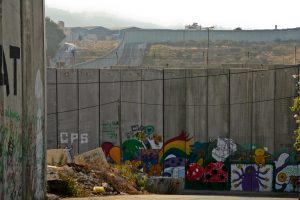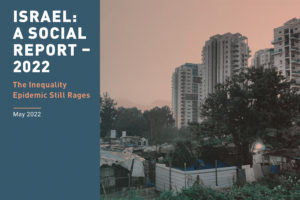Is there any connection between the Corona epidemic and the Israeli occupation of the Palestinian territories?
Is there any connection between the Corona epidemic and the Israeli occupation of the Palestinian territories?
None whatsoever, of course. Even devoted, veteran opponents of the occupation would be hard-put to find a connection. The virus is infecting people all around the globe, including on both sides of the Green Line separating Israel from the Palestinian authority.
What there is, is a clear connection between the epidemic and the way it is being confronted in Israel. Day by day, we are witnessing how countries differ in the way they deal with the virus. In Israel, the occupation is often in the foreground and almost always in the background of most issues concerning public policy. It is not unreasonable to expect a Corona-Occupation connect.
In fact, the connection is quite strong: Israel has a very good public health system, and it entered the Corona crisis with a relatively strong economy; yet due to an occupation-induced policy of fiscal austerity, its health system is functioning on the brink.
The main macro-economic figures for 2019 are: satisfactory GDP growth (3.5%), relatively low budgetary deficit (4.5% GDP), low debt (59.9% GDP), and low unemployment (3.4% among 25-64 year olds).
No less important, Israel entered the Corona crisis with a good public health system. In fact, Israel’s health system, which is mostly public, is the single most important Human Development Index indicator to qualify Israel as a developed country. Average infant mortality (2017) stands at a very good OECD rate of 3.1 infant deaths in the first year of life per thousand live births, and it is constantly improving – over the last decade it decreased, among Israeli Jews, from 2.9 to 2.5, and among Palestinian citizens of Israel, from 6.6 to 4.8. Life expectancy at birth is also high – 80.6 for Jewish men and 78 for Israeli Palestinian men; 85.1 for Jewish women and 82.3 for Israeli Palestinian women. Israel ranks high also on the measure of healthy life expectancy at birth – 66.2 for women and 65.9 for men.
Israel stands in a good place on the Corona front, too. The Ministry of Health, possibly the most professional and efficient civilian government agency, was on top of the pandemic as soon as the first warning signs came in from Wuhan in China. The officials in charge gave out early warnings, embarked upon an intelligent campaign of public education, and soon convinced the government to introduce social distancing policies, starting early on with a gradual stop to international air traffic. Those officials, as well as CEOs of the major public hospitals and HMOs, themselves often former high officials in the Ministry of Health, became daily features on the evening news programs of the three major TV channels, gaining credibility with time, as their model-based predictions proved reliable.
Thus far, the results are quite good: the rate of Corona contagion is comparatively slow, the percentage of serious cases is not particularly high, and the fatality rate is low. The pattern of the spread in Israel is closer to that of South Korea and Taiwan than to Italy and Spain. The major exceptions being Haredi towns and neighborhoods and Palestinian neighborhoods of Jerusalem unilaterally annexed by Israel in 1967.
Still, the Corona illuminated a serious problem previously of major concern only to health officials and social activists: Israel’s public health system is dangerously under-funded.
How so?
Israel’s National Health Insurance Law assures all permanent residents of Israel both hospital and community care. It is funded by a two-tier health tax paid by employed persons, set at 3.1% of monthly wages up to 60% of the average wage, and at 5% for wages surpassing that amount. The Treasury pays most of the difference between the cost of services provided under the Law and the revenue collected from the health tax.
The Law assures all persons with residency status a relatively generous basket of health services, provided by four major HMOs as well by government hospitals and public healthcare facilities, such as well-baby clinics.
One of the problems of Israel’s public health system is that the Law failed to establish a mechanism for updating the cost of the basket of services consequent to population growth, increases in the cost of inputs, and new technological developments. Once this was realized, procedures were put in place for periodic updating. However, updating has been only partial, and a process of erosion began. Part of the shortfall was to be covered by additional medical insurance policies Israelis were encouraged to purchase, first the semi-public “supplemental” policies marketed by the HMOs themselves; these were followed by a plethora of strictly private offerings by insurance companies. In 2018, national health expenditures (government and households) stood at 7.5 % of GDP – close to those of the Czech Republic (7.5%) and Greece (7.2%) and much less than those of Germany and France (11.2%) and Scandinavian countries such as Norway (10.2%) and Sweden (11.0%). Israeli’s public expenditures were 64% of the total, compared with the OECD average of 71%.
Thus one threat to Israel’s public health system is increasing privatization.
A second threat and the one most germane to our topic is the failure to finance more hospital beds, more medical personnel in hospitals, and more medical equipment. A few examples:
- Israel has (before Corona) 2.2 acute care hospital beds per thousand persons, compared with an average of 3.6 per thousand persons for the OECD as a whole and an average of 4.1 per thousand for Belgium, Holland, Germany, Switzerland and France, whose public health systems are similar to Israel’s.
- Not surprisingly, the average occupancy rate of acute care hospital beds is high – 94%.
- Again, not surprisingly, the average length of hospital stay in Israel is 5.2 days, compared to the OECD average of 6.7 days.
- In the past, Israel could brag about enjoying the highest number physicians/population ratio; today that ratio is low and the future is less than
bright; with a rate of 6.9 medical school graduates per year per 100,000 persons, it lags far behind the OECD average of 13.1. - Nurses, too, are in short supply in Israeli hospitals, and here the future is no brighter: Israel has 24.2 nursing school graduates per year per 100,000 persons, compared with the OECD average of 43.6.
- About half of Israeli doctors are 55 and older, compared with the average of 34% in OECD countries.
These figures are presently driving the intensive campaign waged by the Israeli medical establishment to impose ever stricter social distancing and quarantining. Medical officials are driven by the fear of having to deal with a mass of Corona victims needing medical components that are in short supply, including medical staff, hospital beds and ventilators.
Still, it must be remembered that in contrast to the United States, Israel is in a much better position to deal with the epidemic, due to the fact that it does have a public health system.
So what has all this to do with the Israeli-Palestinian conflict and specifically with the Israeli occupation?
Quite simple, though not necessarily acknowledged by the Israeli leadership: the occupation is constantly being contested by the Palestinians, often leading to violent confrontations. The longest and most violent confrontation was the second Intifada, 2001-2003. Since then there has been a seemingly endless chain of violent “rounds” on the borders of the Gaza Strip.
Each such confrontation causes not only human casualties but also economic damage. The second Intifada (coinciding, at first, with a worldwide crisis in the hi-tech industries) brought about what the Bank of Israel termed the longest economic crisis in Israel’s history: two consecutive years of negative GDP growth, and three consecutive years of negative GDP per capita growth. The impact on Israeli society and economy was traumatic, as evinced in the fact that the package of economic programs proposed by the government towards the end of the hostilities, with a view towards economic recovery, was named “Economic Defensive Shield,” after the IDF campaign that put an end to Palestinian resistance – “Defensive Shield”.
The violent confrontation threatened Israel’s financial stability, a key factor in the calculation of a country’s international credit rating. One way of remedying such a situation is to lower the national debt, so that investors are assured that their money is safe. At the peak of the second Intifada, Israel’s national debt stood at more than 100% GDP.
Following the second Intifada, Israel embarked on a consistent policy of fiscal austerity, in order to convey to the local and international business communities a sense of financial stability — a veritable smoke screen for the actual instability resulting from the occupation. Adopting the 2004 Law for the Reduction of the Budgetary Deficit and the Capping of Budgetary Expenditures, Israel cut its debt to 60% GDP – a rate lower than that of quite a few members of the EU, even though it is the rate recommended by the European Union under the Maastricht Agreement of 1993. It was a self-imposed policy of fiscal austerity, four years before the EU Central Bank began dealing with the 2008 world financial crisis by imposing fiscal austerity on “deviant” members of the European Union, such as Greece.
Fiscal austerity “succeeded”: governmental civilian expenditures (excluding military outlays and interest payments) stood, in 2018, at 32.3% of GDP, significantly lower than the OECD average of 40.9%. The “operation” succeeded, but the “patient” – Israel’s social services – including its public health system – sickened from the malaise of underfunding.
Was there an alternative? Certainly: there always is. Israel could have raised taxes to pay for the costs of the Intifada, just as it had done to pay for the 1967 and 1973 wars. However, instead of raising taxes, the then Minister of Finance, Benyamin Netanyahu, did the exact opposite: He lowered them, for the benefit of high earners, absolving them, in a sense, of the necessity of covering the cost of the occupation. “Tax relief,” it should be said, began in the late 1980s, when Israel was emerging from a long inflationary crisis caused by the 1973 war; but the process of tax reduction was accelerated by the second Intifada. It has continued almost steadily ever since. State revenues as a percentage of GDP decreased from 43% in 1986 to 30% in 2009. Today tax revenues stand at 32.4% of GDP – one of the lowest rates in the OECD.
Tax cuts are, of course, a routine conservative way of dealing with everything. They have been a mainstay of Netanyahu’s right-wing, neo-liberal policies. But they also served to allay the assumed fears of Israel’s high-earners, especially members of Israel’s so-called “Start-Up Nation,” in the face of continuing violence, and to discourage thoughts of re-location to the pastures of plenty of Silicon Valley. Thus it was that the liberal, pro-Peace Tel Aviv elite inadvertently became a silent partner to the right-wing goal of holding onto the occupied territories.
Fiscal austerity, of course, has affected not only the poor state of hospitals, medical personnel, medical equipment and supplies. Other losers include the social services for at-risk populations and beneficiaries of Israel’s safety net, including the poor, whose chances of moving out of poverty are now lower than they were before the second Intifada and the Economic Defensive Shield program. At the time of writing, more losers have stepped into the limelight, following the very tight-fisted Corona aid program proposed by Netanyahu’s cabinet to unemployed persons and small businesses.
There may be a little room for optimism here: Perhaps Corona will do the trick. Perhaps the global nature of the Corona virus will bring home the harmfulness of Israel’s occupation of Palestinian territories. Perhaps the renewed prominence of the state in the present crisis will show the absurdity of the persistent drive by neo-liberals to dry up its resources.
A shorter version of this article first appeared on +972 Magazine






